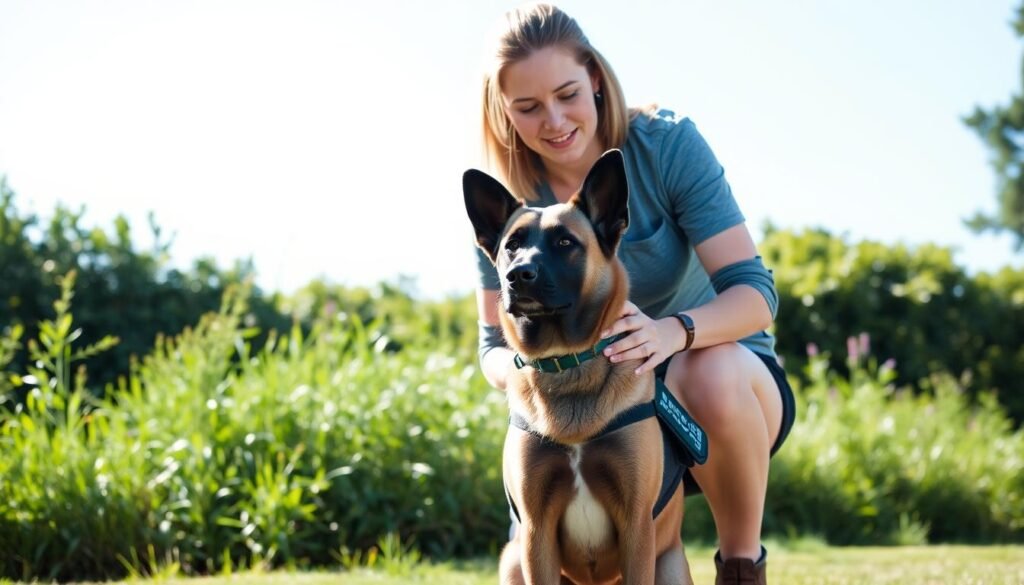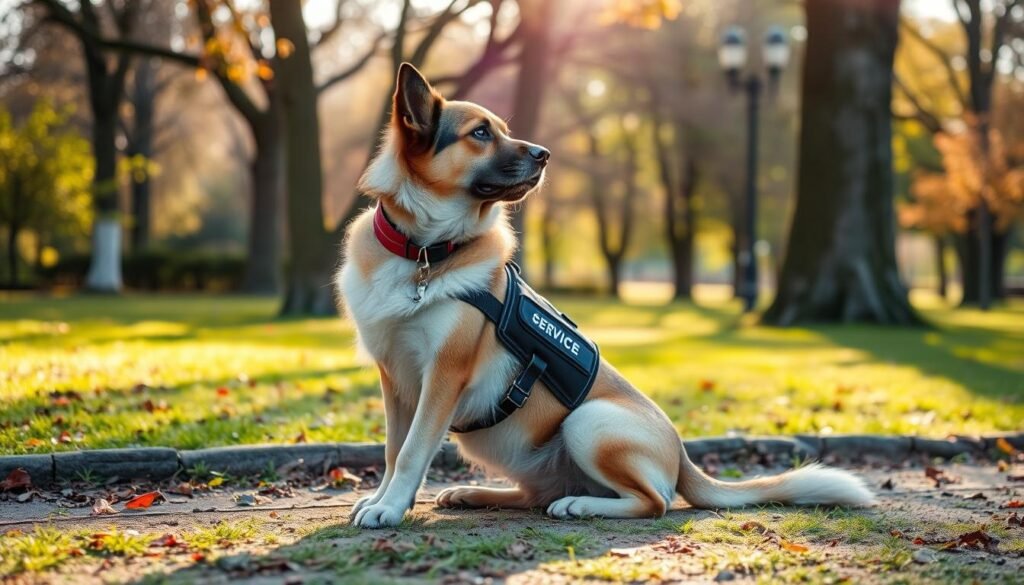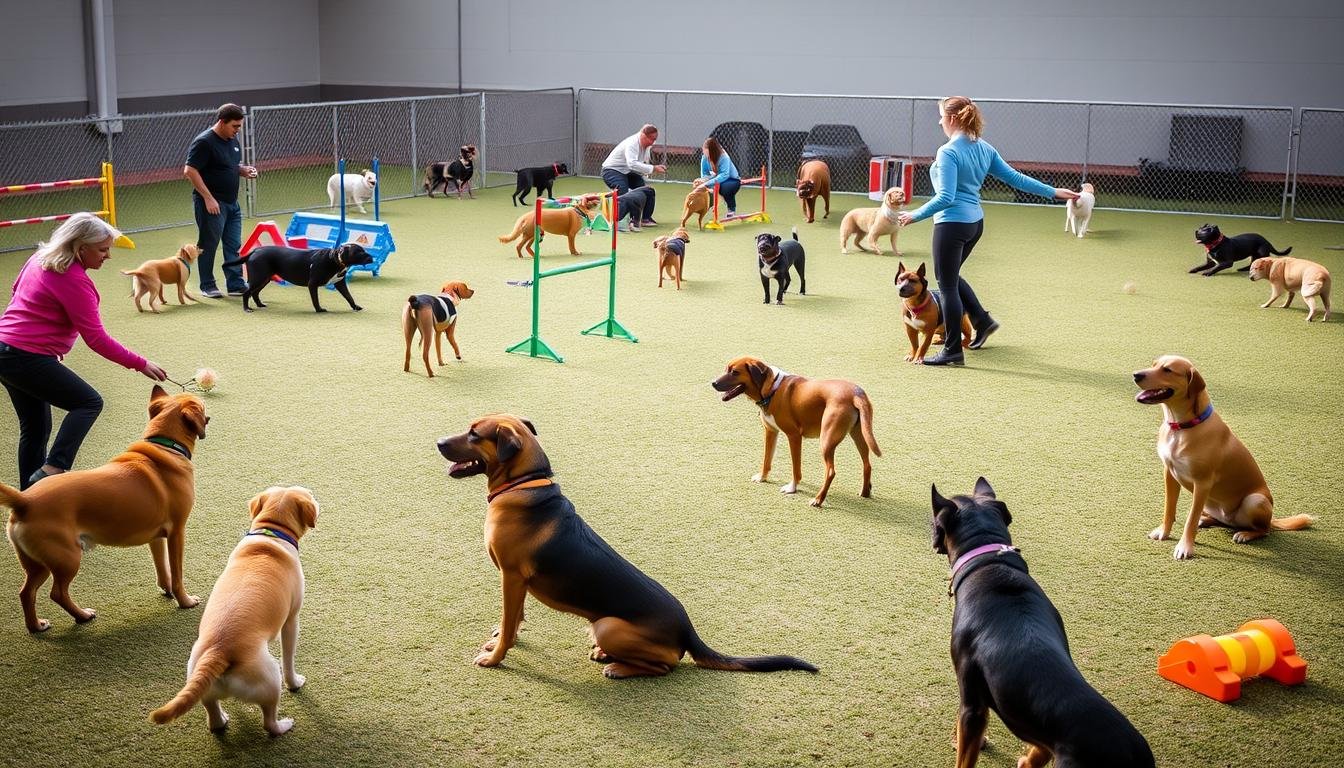8 Specialized Dog Training Programs You Need to Know About for Special Needs
I never thought a dog could change my life so much until I met Max. He’s a golden retriever trained in special programs. Living with a visual impairment, I was unsure about a dog’s help. But Max guided me across a busy intersection, showing the power of service dog training.
Service dogs are more than pets; they’re lifelines for people with disabilities. They go through tough training to do specific tasks for their handlers. From guide dogs to mobility assistance, the training is amazing1.
There are many dog training programs out there. Some teach advanced obedience, while others focus on complex tasks like alerting to medical issues. Each program helps people with special needs, showing how smart and versatile dogs are1.
Exploring service dog training, I found it’s not always easy. The training is tough, with up to 70% of dogs dropping out. This shows how much skill and dedication it takes to train a service dog.
Key Takeaways
- Service dogs undergo specialized training to assist individuals with disabilities
- Various programs exist, from guide dogs to psychiatric support animals
- Training is rigorous, with high dropout rates highlighting the challenge
- Specialized programs address unique needs of individuals with disabilities
- Service dogs are protected under the Americans with Disabilities Act (ADA)
- These animals are not considered pets, but essential assistants
Understanding Service Dog Training Fundamentals
Service dog training has evolved a lot, starting in the 1920s. It has grown from guide dogs for the blind and deaf to many breeds helping people with various disabilities2. I’ve seen how these amazing animals change lives.
What Qualifies as a Service Dog
A service dog is trained to help someone with a disability. The training can last up to two years. These dogs must obey their handler’s commands 90% of the time, anywhere3. It’s a tough standard, but it’s essential for their work.
Legal Rights and Protections
ADA rules give service dogs and their handlers legal rights. They can go into places where pets can’t. There’s a big effort to improve service dog training and access2. Businesses need to know these rules.
Common Service Dog Breeds
Any breed can be a service dog, but some are more common. Here’s a quick look at popular service dog breeds:
| Breed | Common Tasks | Characteristics |
|---|---|---|
| Labrador Retriever | Mobility assistance, item retrieval | Friendly, eager to please |
| Golden Retriever | Guide work, emotional support | Gentle, intelligent |
| German Shepherd | Protection, balance support | Loyal, trainable |
| Poodle | Allergy-friendly assistance | Versatile, hypoallergenic |
Training a service dog is expensive, over $25,0002. Some groups help with costs, but it’s a big investment.

The dedication to service dog training is huge. The international standard is at least 120 hours over six months3. It shows the strong bond between humans and dogs. And the amazing impact these animals have on people’s lives.
Advanced Obedience Training for Special Needs Dogs
Advanced obedience training for special needs dogs is a big step up from regular training. It turns dogs into amazing helpers for people with disabilities. Sadly, only about 10,000 groups can train the 500,000 Americans who need service dogs4.
Basic Command Structure
The base of advanced training is a strong command structure. Dogs learn complex tasks from simple commands like sit, stay, and come. This training can cost between $20,000 and $30,000, showing how detailed it is4.
Trainers use positive methods to build trust and clear communication between dogs and their owners5.
Socialization Techniques
Socializing service dogs is key. They need to stay calm and focused in many places. This training exposes them to various situations, people, and animals.

Behavior Modification Methods
Changing a dog’s behavior is a big part of advanced training. Trainers work to stop bad behaviors and encourage good ones. This is done to meet the specific needs of people with disabilities, as the Americans with Disabilities Act requires5.
| Training Aspect | Duration | Cost |
|---|---|---|
| Basic Obedience | 4-6 weeks | $1,000-$2,000 |
| Advanced Training | 6-12 months | $5,000-$10,000 |
| Full Service Dog Training | 1-2 years | $20,000-$30,000 |
Groups like the Service Dog Academy have trained over 300 medical alert dogs online. This makes advanced training more reachable4. These programs aim to create confident, well-behaved dogs ready to help their owners in many ways.
Medical Alert and Response Dog Programs
Medical alert dogs are very important for people with health issues. They are trained to notice and help with certain health problems. This support is very valuable to their owners.
Diabetic alert dogs can smell changes in blood sugar. They warn their owners about dangerous levels. Seizure response dogs help during and after seizures.

Allergy detection dogs are also important. They can find allergens in food and places. This helps prevent serious allergic reactions.
The ADA lets any dog breed be a service dog. But some breeds are better for certain jobs. Labrador Retrievers are great for medical alert work because they smell well and are friendly6.
Choosing a medical alert dog needs careful thought. Consider the dog’s size, personality, and strength. For example, smaller dogs might be better for alert tasks, while bigger dogs are better for helping with mobility6.
| Type of Medical Alert Dog | Primary Function | Common Breeds |
|---|---|---|
| Diabetic Alert Dogs | Detect blood sugar changes | Labrador Retrievers, Golden Retrievers |
| Seizure Response Dogs | Assist during epileptic episodes | German Shepherds, Labrador Retrievers |
| Allergy Detection Dogs | Identify possible allergens | Poodles, Portuguese Water Dogs |
Training medical alert dogs is all about scent and response. They learn a lot to be reliable. Trainers with over 40 years of experience use positive methods to teach them7.
Service dogs, like medical alert dogs, have legal protection. This means they can go anywhere with their owners. They are protected in public places, work, and homes7.
Specialized Dog Training Programs for Mobility Assistance
Mobility assistance dogs are key to helping people with physical disabilities live more independently. These dogs go through tough training to help with everyday tasks.

Balance Support Training
Balance dogs help their handlers stay steady. They learn to help with standing and moving around safely8. This training is all about being precise and safe for both the dog and the handler.
Wheelchair Assistance Skills
Wheelchair service dogs are trained to help people in wheelchairs. They learn to push wheelchairs, open doors, and get items8. Big dogs like Labradors and Golden Retrievers are often picked for their strength9.
Item Retrieval Techniques
Item retrieval is a big part of their training. Dogs learn to pick up things, get medication, and fetch items on command8. This helps their handlers be more independent and need less help from others.
| Task | Description | Benefit |
|---|---|---|
| Forward Momentum Pull | Dog assists in moving handler forward | Improves mobility and reduces fatigue |
| Counterbalance | Dog provides stability while walking | Prevents falls and increases confidence |
| Light Switch Operation | Dog turns lights on/off | Enhances independence in home environment |
Training a mobility support service dog takes about a year9. Places like Dog Training Elite offer special programs. They train dogs in the owner’s home to build a strong bond8.
“Our mobility service dog has transformed our daily life, providing not just physical support but also companionship and emotional comfort.”
With the right training, mobility assistance dogs become essential partners. They greatly improve the lives of people with physical disabilities.
Psychiatric Service Dog Training
Psychiatric service dogs are vital for people with mental health issues. They go through tough training to help their owners with different mental health problems.
PTSD Support Training
PTSD dogs help those with post-traumatic stress disorder. They learn to stop nightmares, act as a shield in crowded places, and do deep pressure therapy to calm anxiety1011.
Anxiety Response Protocols
Anxiety support dogs are trained to help during panic attacks. They learn to notice when their owner is anxious and respond with calm actions, like nudging10.

Depression Management Techniques
Depression assistance dogs help people with clinical depression. They can remind owners to take their meds, encourage exercise, and offer comfort when it’s hard11.
Teaching psychiatric service dogs includes basic skills like sit, stay, and come. They also learn special tasks like guiding people, searching rooms, and getting help when needed1012.
| Training Type | Key Tasks | Benefits |
|---|---|---|
| PTSD Support | Nightmare interruption, creating physical barriers | Reduced anxiety, improved sleep |
| Anxiety Response | Recognizing anxiety cues, providing calming behaviors | Panic attack prevention, stress reduction |
| Depression Management | Medication reminders, encouraging physical activity | Improved mood, increased daily functioning |
With over 40 years of experience, specialized training programs offer deep support for mental health. Clients have shared how these programs have greatly helped, showing big improvements in the dogs’ behavior and how well they respond to commands12.
Hearing and Visual Assistance Dog Programs
I’ve found that hearing and visual assistance dog programs change lives. Guide dogs help people who are blind by navigating through places. Hearing dogs alert their owners to sounds like doorbells and smoke alarms13.
Training these dogs costs a lot, sometimes over $20,0001413. This money pays for the long training, which can take months13. Groups like Canine Companions for Independence help keep these partnerships strong15.

Guide dogs are key for people who are blind, helping them move around and be independent. Organizations like Guide Dogs for the Blind help across the U.S. and Canada15. Hearing dogs, often small breeds, help those who are deaf13.
Some programs, like Dogs for the Deaf, train dogs from shelters for deaf people15. Getting a dog through these programs can take a while, with some waiting two months14.
There are also dogs for people who are both deaf and blind. These dogs need special training to help with both hearing and sight loss. Their training is very detailed, showing their important role.
It’s good to know that some groups give their dogs away for free, thanks to donations13. In California, there’s a program that helps with the cost of these special dogs15.
Therapy Dog Training Certification Programs
Therapy dog certification programs are key in getting dogs ready for their work. They aim to make dogs friendly and well-behaved. This helps them offer comfort in many places.
Hospital Visitation Requirements
Hospital therapy dogs have to meet certain rules. They must be at least one year old, house trained, and up to date on shots16. They also need to be well-groomed. These dogs go through tough training to safely interact with patients and staff.
Emotional Support Protocols
Therapy dogs help in hospitals, nursing homes, schools, and libraries16. They help lower stress, fight depression, and comfort people with disabilities16. Their training helps them understand how to connect with people of all ages.
Therapy Dog Testing Standards
To get certified, pets must pass an obedience test and show they can handle special situations16. The AKC has different levels based on visits:
- AKC Therapy Dog Novice: 10 visits
- AKC Therapy Dog: 50 visits
- AKC Therapy Dog Advanced: 100 visits
- AKC Therapy Dog Excellent: 200 visits
- AKC Therapy Dog Distinguished: 400 visits17
These standards make sure therapy dogs are ready to comfort and support those who need it.
Autism Support Dog Training Methods
Autism service dogs are a big help to people with autism. They get trained hard to face many challenges. They learn to help with feeling, social skills, and staying safe.

Getting a trained autism service dog costs about $15,90018. Families feel less stressed with these dogs around. They feel more at ease in public and calm at home19. These dogs also make the whole family feel better19.
Training for autism support dogs includes:
- Sensory assistance
- Deep pressure tasks
- Redirecting repetitive behaviors
- Ensuring safety
It can take 18-24 months to get an autism assistance dog18. These dogs help lower stress in kids with autism. They also help those who get stressed easily19.
Places like Dog Training Elite have been training for over 40 years19. They focus on the bond between the dog and the family19. They aim to give emotional support and friendship19.
| Training Aspect | Details |
|---|---|
| Average Cost | $15,900 |
| Waiting Period | 18-24 months |
| Health Guarantee | One-year |
| Experience | 40+ years |
More people are using service dogs for autism. This shows they are accepted and valued in the autism community19. Autism service dogs are making a big difference in people’s lives.
Professional Training Organizations and Costs
I’ve looked into service dog training organizations to help you grasp the cost and training time. The world of training dogs for special tasks is complex. There are many programs for different needs.
Accredited Training Centers
Accredited centers provide top-notch training but it’s pricey. Basic obedience for adult dogs costs between $500 and $3,000 for a few weeks. Service dog training can cost from $5,000 to $25,000 or more20. These centers follow strict standards for quality training.
Financial Assistance Options
The cost of service dogs can be overwhelming, but help is available. Non-profit groups offer trained dogs at lower or no cost to those who qualify. Some training centers also have payment plans to ease the financial burden.
| Program | Full Payment | Monthly Plan |
|---|---|---|
| Core Skills – Pro Dog Trainer | $1,261 | $99 down, $144/month for 12 months |
| Basics Pro – Dog Training & Behavior | $2,933 | $199 down, $286/month for 12 months |
| Master Class Certification | $5,226 | $990 down, $287/month for 18 months |
These options from professional training organizations show the range of costs and payment plans available21.
Training Timeline Expectations
The training for service dogs usually takes 18-24 months. This includes raising the puppy, basic obedience, and task training. The cost depends on the program’s length and intensity20. It’s important to be patient as thorough training is key for a well-prepared service dog.
While the process may seem long and expensive, the end result is a loyal companion. They are trained to help with specific needs, improving your life quality.
Conclusion
I’ve looked into specialized dog training programs and seen huge progress in service dog training. These dogs are now trained for many tasks, like alerting to medical issues or helping with mobility. It’s clear that specialized dog training changes lives22.
The future of assistance dogs is promising. Training methods have moved from just obedience to science-backed approaches. Now, trainers work on building a strong bond between dogs and humans, leading to better teamwork22. This change has opened up new areas like search and rescue and improved how humans and dogs interact.
Training costs can vary, but basic obedience classes usually cost between $100 and $300 for a few weeks. Private sessions can be $50 to $150 an hour23. While specialized programs might cost more, the benefits are often life-changing. I’m looking forward to seeing how these amazing animals will continue to improve our lives in new ways.
FAQ
What is a service dog?
A service dog is a dog trained to help someone with a disability. They do specific tasks that help their owner. These tasks are covered by the Americans with Disabilities Act (ADA). Service dogs are not pets and have special rights, like going into public places.
How long does it take to train a service dog?
Training a service dog takes about 18-24 months. This includes learning basic obedience and specific tasks. The training is tough, with up to 70% of dogs dropping out.
What breeds are commonly used as service dogs?
Labrador Retrievers, Golden Retrievers, and German Shepherd Dogs are often used. Poodles are also popular because they come in different sizes. But, any breed can be a service dog if it has the right personality and skills.
How much does a professionally trained service dog cost?
Professional training for a service dog can cost over ,000. But, many non-profits offer service dogs for free or at a low cost to those who qualify. It’s smart to look for financial help if you’re thinking about getting a service dog.
What’s the difference between a service dog, therapy dog, and emotional support animal?
Service dogs are trained to help people with disabilities and have legal rights. Therapy dogs comfort people in places like hospitals but don’t have the same rights. Emotional support animals are for companionship but aren’t trained for specific tasks. It’s key to know the differences.
Can I train my own service dog?
Yes, you can train your own service dog, but it’s best to get professional help. Training a service dog is complex and needs a lot of knowledge. Professional trainers make sure the dog is reliable and safe.
What types of tasks can service dogs perform?
Service dogs can do many tasks, depending on what their owner needs. They can guide the blind, alert the deaf, help with mobility, detect medical issues, and help with mental health symptoms.
Are service dogs required to wear vests or identification?
Service dogs don’t have to wear vests or show ID under the ADA. But, many owners use vests or ID tags to show their dog is a service animal. Businesses can ask if the dog is for a disability and what it does, but they can’t ask for proof.
Source Links
- 8 Types of Specialized Dog Training: Facts & Pictures – Dogster
- No title found
- Service Dog Training Guide – The Basics
- The World’s Best Service Dog Training Schools
- Elite Service Dog Training. DTE
- Service Dog Training Programs | Service Dog Training School International
- Elite Service Dog Training in Los Angeles, CA. DTE
- Mobility Service Dog. Dog Training Elite
- Mobility Service Dog – Ranger Dog Training
- Psychiatric Service Dog Training – Healing Companions
- Training a Psychiatric Service Dog: A Complete Guide
- Psychiatric Service Dog in Howard County, MD. DTE
- No title found
- Hearing Service Dog Training | Programs | Paragon Service Dogs
- ANIMAL ASSISTANCE
- Certified Therapy Dog/Animal Training Course
- No title found
- Autism Service Dogs & Service Dog Training | Highland Canine Training
- Autism Support Dog Training. Dog Training Elite
- Dog Training Cost: What You Need to Know
- Courses and Tuition – CATCH Canine Trainers AcademyCATCH Canine Trainers Academy
- Life Lessons Learned From Training Dogs – Whole Dog Journal
- What to Expect from Professional Dog Training Programs — The Trusted Companion
editor's pick
latest video
news via inbox
Nulla turp dis cursus. Integer liberos euismod pretium faucibua

